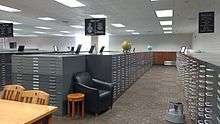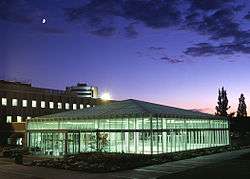Harold B. Lee Library
|
Library main entrance | |
| Country | United States |
|---|---|
| Type | Academic library |
| Established | 1961 |
| Location | Provo, Utah |
| Coordinates | 40°14′57″N 111°38′57″W / 40.24917°N 111.64917°WCoordinates: 40°14′57″N 111°38′57″W / 40.24917°N 111.64917°W |
| Collection | |
| Size | 9.82M (As of 2011)[1] |
| Access and use | |
| Circulation | 536,000 (As of 2011)[2] |
| Population served | Brigham Young University |
| Other information | |
| Director | Jennifer Paustenbaugh[3] |
| Staff | 352 FTE (As of 2011) |
| Website |
lib |
The Harold B. Lee Library (HBLL), located in Provo, Utah, is the main academic library of Brigham Young University (BYU), the largest religious and private university in the United States.[4][5] The library has approximately 98 miles (158 km) of shelving for the more than 6 million items in its various collections, as well as a seating capacity for 4,600 people. With over 10,000 patrons entering the building each day,[6] The Princeton Review consistently ranks the HBLL in the nation's Top Ten University Libraries–#1 in 2004[7] and #3 in 2012.[8] Named for Harold B. Lee, former president of The Church of Jesus Christ of Latter-day Saints (LDS Church), the library's motto is "...Learning by study and also by faith."[9][10]
History
The HBLL began as a small collection of books kept in the office of Karl G. Maeser during his time as principal of then-Brigham Young Academy. The small library relied almost exclusively on gifts, donations, and free material from the U.S. Government. When Maeser's office was destroyed by a fire in 1884, his library collection went with it. By the time the Education Building was completed in 1892, a new library had been formed and a room was provided on the second floor of the new building.
The academy later became a university, which spurred the library's growth until it filled the third floor and much of the second floor of the Education building. In July 1924, the alumni association reported that $125,000 had been appropriated to construct a new library building to be erected on University Hill. The new Heber J. Grant Library was subsequently dedicated on October 15, 1925 with 40,000 books and 35,000 pamphlets were moved into their new home.
By 1950, the collection had long since outgrown the Grant Library, and books were stored in almost all campus buildings. The lack of adequate space in the Grant Library lead to the location of libraries in other buildings on campus during the 1950s. The Physical Science Library was housed in the Eyring Science Center from the opening of that building in 1950. In 1957 when the Joseph F. Smith Family Living Center was opened, it contained the life science library on the first floor and the music library on the third floor. The pre-1940 bound periodicals were being stored in the basement of BYU's Joseph Smith Memorial Building. The reserve library was located in the David O. McKay Building, while the attics of the Maeser Building and the women's gymnasium used for storage as well as a warehouse in downtown Provo.[11]
Ernest L. Wilkinson appointed a faculty committee to survey library needs in January 1953. As a result of the study, the J. Reuben Clark Library was constructed to help accommodate the growing collections of the Grant Library. In 1961, 300,000 volumes were moved into the Clark Library, although the building was not dedicated until October 10, 1962.[6]
|
"Of all the wonderful buildings that we have on [the BYU] campus, none, I believe, is as important as the library. A library is the very heart and substance of a university." |
| — Gordon B. Hinckley[6] |
The new library was designed by Lorenzo Snow Young with Keyes D. Metcalf, Librarian-emeritus of Harvard serving as a counsultant. It was built by the Garff, Ryberg, and Garff Construction Company. Another key figure in the planning and building of the library was S. Lyman Tyler, who at the time was the director of the BYU Library.[12] With the expansion of the library building came the expansion of the library collection. In 1971 the library celebrated the acquisition of their millionth volume with a conference on library acquisition and a luncheon for donors.[13]:114
In 1973, the name of the J. Reuben Clark Library was changed to the Harold B. Lee Library, in honor of the former president of the LDS Church. In order to keep up with the needs of the academic community and the church, construction began in 1974 on a library addition of 215,000 square feet (20,000 m2). This addition was occupied in the summer of 1976 and dedicated March 15, 1977.[14]
As the university continued to grow, so did the library collections and need for additional space. To help fill this need, ground was broken on September 20, 1996 for another addition to the library. In the four years of construction, roughly 235,000 square feet (21,800 m2) were added to the library, most of it underground. When the new addition was dedicated on November 15, 2000, the library was 665,000 square feet (61,800 m2).[6] Since then, the library has focused more on digital expansion, adding access to several electronic books and scholarly databases from on- and off-campus.[15] Today, the library is supported by 351 full-time equivalent employees.[16]
Collections
The HBLL includes a family history library, the Primrose International Viola Archive,[17] the International Harp Archives,[18] and serves as a designated depository of government documents. In January 2010 the juvenile literature department opened its Lloyd Alexander Collection, featuring items from the author's home office for students and researchers to access.[19]
Special Collections
The L. Tom Perry Special Collections Library, named for an LDS Church apostle, preserves and makes available rare unique library materials in original and digital forms. Originally established in 1957 under the direction of Chad J. Flake,[13]:141 the library holds 350,000 rare books and print matter, over 1,000,000 photographs, and 10,000 manuscript and archival collections. The library also offers numerous exhibits, lectures, tours, and conferences related to its holdings.[20] The collection includes a 1967 Biblia Sacra illustrated by Salvador Dalí, a 1555 Biblia translated by Martin Luther, a 13th-century hand-copied Latin Vulgate Bible, a Turkish New Testament from 1905, a page from the Bible produced by Johannes Gutenberg in about 1450, and four first-edition copies of the Book of Mormon. Other artifacts include four 4,000-year-old cuneiform tablets, six Oscars, and ten Ansel Adams photographs.[21]
In 1983, after the commercial flop of The Magic of Lassie, Jimmy Stewart went into semi-retirement and donated his papers, films, and other records to the HBLL. The library's collections also include the Cecil B. DeMille papers.
Foreign Language Collections
The HBLL houses collections in many foreign languages. It houses a Welsh library originally sponsored in 1951 by the National Gymanfa Association of the United States and Canada.[13]:75 The Icelandic Library Association of Spanish Fork also donated their collection of Icelandic books in 1951.[13]:75

Map Collection
The map collection at the HBLL is located on the second floor and is considered "one of the best collections of printed maps in the area."[22] It contains approximately 240,000 maps, 5,500 atlases and gazetteers, and various online geographic resources. [23] The map collection also contains a geospatial services and training lab which assists students and faculty with maps, data management, spatial analysis, and geographic information systems (GIS). [24]
Media attention
In July 2010, the HBLL received nationwide attention for a parody on an Old Spice commercial that was filmed inside the library.[25] In April 2011, a cappella group Vocal Point recorded the music video for their rendition of "Jump, Jive, an' Wail" in the HBLL.[26]
References
- ↑ "Library Statistics (General)". Brigham Young University. Retrieved 17 Aug 2013.
- ↑ "Library Statistics (Circulation)". Brigham Young University. Retrieved 17 Aug 2013.
- ↑ Kling, Chadra (27 Mar 2013). "OSU's Jennifer Paustenbaugh named University Librarian at BYU". BYU News (Press release). Brigham Young University. Retrieved 17 Aug 2013.
- ↑ Naparsteck, Martin. "The Lord's University". Salt Lake Tribune. Archived from the original on December 13, 2007. Retrieved 2008-05-01.
- ↑ "Brigham Young University, Provo". CollegeAtlas.org. 2013. Retrieved 2014-02-05.
- 1 2 3 4 "History of the Library". Brigham Young University. Retrieved 2016-01-14.
- ↑ "YFacts". Brigham Young University. Retrieved 2016-01-15.
- ↑ "BYU's Harold B. Lee Library Ranked 3rd in Nation". Brigham Young University. Retrieved 2015-01-15.
- ↑ "HBLL Homepage". Brigham Young University. Retrieved 2008-05-15.
- ↑ "Doctrine and Covenants". LDS Church. Retrieved 2008-05-15.
- ↑ Wilkingson, Ernest L. and Leonard J. Arrington, ed., Brigham Young University: The First 100 Years (Provo: BYU Press, 1976) p. 21-23
- ↑ Wilkinson and Arrington, ed., BYU: the 1st 100 years, Vol. 3, p. 23-24
- 1 2 3 4 Knight, Hattie (1976). Brigham Young University Library Centennial History 1875-1975. Harold B. Lee Library, Brigham Young University.
- ↑ "Case Study". ST Imaging. Retrieved 2008-05-15.
- ↑ "A Library for the World". BYU Magazine. Retrieved 2016-01-15.
- ↑ "HBLL Stats". Brigham Young University. Archived from the original on 2008-05-09. Retrieved 2008-05-15.
- ↑ "Primrose International Viola Archive". American Viola Society. Retrieved 2016-01-14.
- ↑ "15th National Competition & Anne Adams Awards Auditions". American Harp Society. Archived from the original on November 2, 2007. Retrieved 2008-05-15.
- ↑ "The Harold B. Lee Library to Celebrate the Opening of the Lloyd Alexander Collection". Harold B. Lee Library. 2009-12-19. Retrieved 2015-01-25.
- ↑ "L. Tom Perry Special Collections Homepage". Brigham Young University. Retrieved 2008-05-15.
- ↑ McClellan, Jeff (2001-06-01). "Collected Memory". BYU Magazine. Retrieved 2008-05-15.
- ↑ "Library News". Harold B. Lee Library. 9 Mar 2012. Retrieved 10 May 2016.
- ↑ "Maps, Atlases and Gazetteers: General Info". Brigham Young University. Retrieved 10 May 2016.
- ↑ "Geospatial Technology: Find Help at BYU". Brigham Young University. Retrieved 2016-05-10.
- ↑ "Transcript of CNN Newsroom video". CNN. 25 July 2010. Retrieved 2016-01-15.
- ↑ "BYU's Vocal Point a cappella group celebrates 20 years". Brigham Young University. Retrieved 10 April 2011.
External links
| Wikimedia Commons has media related to Harold B. Lee Library. |
- L. Tom Perry Special Collections home page
- Map Collection page
- Scholars Archive, an open repository for BYU theses, dissertations, and journals
- BYU Harold B. Lee Library at FamilySearch Research: Wiki for genealogists
- byutv Backstage documentary about HBLL
- A. Dean Larsen Harold B. Lee Library files collection containing library acquisitions, MSS 2207 at L. Tom Perry Special Collections, Brigham Young University
- Harold B. Lee Library addition construction : photo overview, MSS SC 3064 at L. Tom Perry Special Collections, Brigham Young University
- Harold B. Lee Library biennial and annual reports, UA 1015 at L. Tom Perry Special Collections, Brigham Young University
